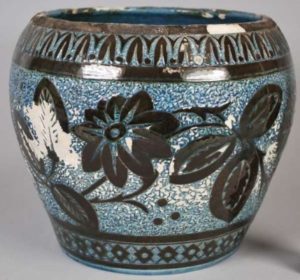This pot is named after the French word for a gardener – jardinière – as it often displayed plants. Charles H Brannam made this jardinière in 1884, and James Dewdney decorated it. They worked at the Litchdon Pottery in Barnstaple.
Charles’ father, Thomas, established the Litchdon Pottery in 1847. Born in 1855, Charles worked at the pottery from the age of 12. Under Thomas, Litchdon mainly produced ‘peasant’ pottery such as pitchers and pans. These items featured only simple decoration. Having studied the ceramics in London’s museums, Charles persuaded his father to experiment with art pottery. Charles took over in 1881 and recruited skilled designers to improve production standards.

The Litchdon Pottery enjoyed rising success with Charles’ pottery selling across London. It received publicity in 1885 when an order came from Queen Victoria. This led to patronage from other members of European Royal families. Charles now registered the name ‘Royal Barum Ware’ for his art pottery, ‘Barum’ being the Roman name for Barnstaple. He established his own London outlet, producing ceramics well into the twentieth century.
Charles used traditional local styles, like sgraffito decoration. He also experimented with carved and applied ornament, and deep-coloured glazes. Much art pottery design at the time drew inspiration from Japanese, Persian and Classical motifs.
The earthenware body of this jardinière features sgraffito decoration. This process is often associated with North Devon pottery. Meaning ‘to scratch’ in Italian, it involved carving into an outer layer of coloured slip to reveal the clay body beneath. In this way, you could etch a design onto the surface of the ceramic.
This content is viewable by members only. Login or sign up to get access.

